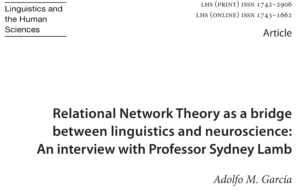Relational network theory as a bridge between linguistics and neuroscience: An interview with Professor Sydney Lamb
Linguistics and the Human Sciences
García, A. M. (2013). Relational network theory as a bridge between linguistics and neuroscience: An interview with Professor Sydney Lamb. Linguistics and the Human Sciences 8(1), 3-27. Online: http://bit.ly/19Q44G5.
Sydney Lamb es el creador y principal desarrollador de la Teoría de Redes Relacionales (RNT), un modelo neurocognitivo del lenguaje. El principal manifiesto de la teoría, titulado «Caminos del Cerebro», fue publicado en 1999. En varias conferencias dadas desde entonces, Lamb ha introducido una serie de refinamientos, la mayoría de los cuales no han aparecido en la prensa. Además, Pathways of the Brain deja abiertas varias cuestiones que resultan cruciales para los seguidores de la teoría durante mucho tiempo y para los recién llegados. En esta entrevista, el Profesor Lamb discute los aspectos históricos, técnicos y prácticos de RNT, abordando tanto las innovaciones recientes como las preguntas recurrentes.
Para acceder al artículo hacé click AQUÍ
Relational network theory as a bridge between linguistics and neuroscience: An interview with Professor Sydney Lamb
Linguistics and the Human Sciences
García, A. M. (2013). Relational network theory as a bridge between linguistics and neuroscience: An interview with Professor Sydney Lamb. Linguistics and the Human Sciences 8(1), 3-27. Online: http://bit.ly/19Q44G5.
Sydney Lamb is the creator and main developer of Relational Network Theory (RNT), a neurocognitive model of language. The theory’s major manifesto, titled Pathways of the Brain, was published in 1999. In several conferences given since then, Lamb has introduced a number of refinements, most of which have not appeared in print. Besides, Pathways of the Brain leaves open several questions which prove crucial to the theory’s long-time followers and newcomers alike. In this interview, Professor Lamb discusses historical, technical, and practical aspects of RNT, addressing both recent innovations and recurring queries.
To access the full paper please click here


